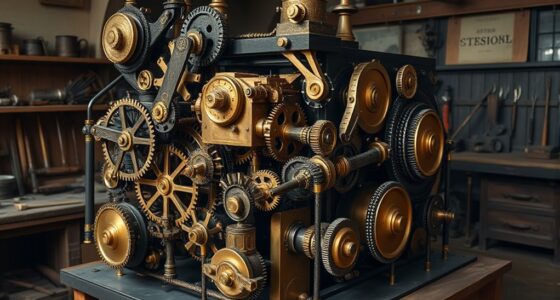Cyberpunk tech envisions a future filled with neon-lit streets, holograms, and cybernetic enhancements, emphasizing digital innovation and virtual realities. In contrast, steampunk showcases Victorian-era machinery, brass gears, and steam-powered inventions, celebrating mechanical craftsmanship and tactile design. While cyberpunk explores cybernetics, hacking, and cyberspace, steampunk focuses on analog devices and manual labor. By exploring both, you’ll discover how each genre shapes our view of past and future technologies—if you explore further, you’ll uncover deeper insights into their distinctive worlds.
Key Takeaways
- Cyberpunk showcases sleek, neon-lit digital environments with advanced cybernetics, while steampunk features Victorian-era machinery and brass devices.
- Cyberpunk emphasizes digital connectivity, hacking, and virtual realities; steampunk focuses on steam-powered, manual craftsmanship.
- Cyberpunk reflects societal fears of unchecked technological growth and AI; steampunk romanticizes industrial age innovation and Victorian values.
- Cyberpunk involves human-machine merging through cybernetics; steampunk centers on mechanical devices without digital augmentation.
- Cyberpunk’s aesthetic is futuristic and sleek; steampunk’s is vintage, ornate, and mechanical.

Have you ever wondered how cyberpunk and steampunk technologies differ in their approach to the future? The contrast is striking once you start exploring their unique aesthetics and philosophies. In cyberpunk worlds, the streets are bathed in neon lights, creating a vibrant, often dystopian atmosphere. The neon lit streets serve as a visual symbol of the high-tech, low-life culture that dominates these settings. You see towering skyscrapers covered in holographic advertisements, and the city pulses with digital energy. Cyberpunk technology emphasizes connectivity, hacking, and the integration of cyberspace into everyday life. It’s about a future where advanced computers, cybernetics, and virtual realities shape society, often highlighting the potential dangers of unchecked technological growth and corporate control. This genre also explores the ethical dilemmas of human augmentation and artificial intelligence, reflecting societal anxieties about technological progress.
Neon-lit streets and holographic ads define cyberpunk’s high-tech, dystopian vision of a digital, interconnected future.
In stark contrast, steampunk envisions a future rooted in the past, drawing on Victorian machinery and steam-powered inventions. You’ll notice intricate brass gears, clockwork mechanisms, and elaborate steam engines that power everything from airships to automata. This genre romanticizes the industrial age, imagining a world where technology evolved along a different timeline—one where craftsmanship and mechanical ingenuity reign supreme. The aesthetic is characterized by rich, ornate designs and a sense of craftsmanship that emphasizes manual labor and mechanical complexity. Instead of digital interfaces, you find levers, cogs, and levers, reflecting a society that relies on meticulous engineering rather than digital innovation.
While cyberpunk technology is often characterized by sleek, futuristic designs and digital interfaces, steampunk’s charm lies in its Victorian machinery and analog systems. Cyberpunk explores a future where humans merge with machines—cyborgs, neural implants, virtual worlds—highlighting how technology blurs the line between human and machine. Conversely, steampunk focuses on mechanical devices and steam-powered innovations, emphasizing human craftsmanship and mechanical mastery. Both genres imagine worlds shaped by technology, but their visions couldn’t be more different: one is a neon-lit, cybernetic future, the other a Victorian-inspired, gear-driven bygone era.
In essence, cyberpunk looks forward, emphasizing digital innovation, hacking, and a cybernetic society, while steampunk looks back, celebrating mechanical ingenuity, Victorian machinery, and a nostalgia for the industrial age. Your perception of the future is influenced by these contrasting visions, shaping the stories, aesthetics, and technologies that define each genre. Whether you’re drawn to the glowing chaos of cyberpunk’s neon streets or the intricate elegance of steampunk’s Victorian machinery, both offer compelling views of what the future—or the past—might hold. Additionally, the use of sulfate-free products in hair care is increasingly popular for maintaining vibrant colors without damaging hair, reflecting a modern emphasis on health-conscious choices that align with the innovative spirit of cyberpunk and the craftsmanship of steampunk.
Frequently Asked Questions
How Do Cyberpunk and Steampunk Cultures Influence Technology Design?
You see how cyberpunk fashion influences technology design with its sleek, neon-lit aesthetics, emphasizing a futuristic, rebellious vibe. Meanwhile, steampunk aesthetics inspire designs that blend Victorian elegance with industrial elements, creating a nostalgic yet innovative look. These cultures shape tech by prioritizing style and identity, pushing creators to develop products that reflect their unique worlds. Your appreciation for these influences helps fuel ongoing innovation rooted in distinct visual and cultural expressions.
What Are the Environmental Impacts of Retro Versus Futuristic Tech?
You should consider how retro technology often faces recycling challenges due to outdated materials and design, making disposal tricky. Futuristic tech, on the other hand, tends to focus on energy efficiency but can still impact the environment through resource extraction for advanced components. Both styles influence environmental impacts, with retro tech struggling with waste and futuristic tech demanding high energy consumption, highlighting the need for sustainable design choices.
How Do User Interfaces Differ Between Cyberpunk and Steampunk Devices?
Imagine you’re using a device with neon aesthetics and mechanical controls, like a sleek cyberpunk gadget. Your interface likely features holographic displays, touch panels, or voice commands, emphasizing sleek, futuristic interaction. In contrast, steampunk devices often have brass dials, gears, and physical levers, creating a tactile experience. You feel the difference—cyberpunk’s high-tech, immersive interfaces versus steampunk’s vintage, mechanical controls—each shaping how you engage with technology uniquely.
Are There Real-World Examples of Steampunk or Cyberpunk-Inspired Technologies?
You’ll find real-world examples inspired by cyberpunk and steampunk designs in current tech. Augmented reality glasses and wearable devices reflect cyberpunk’s futuristic aesthetic, blending digital interfaces with daily life. Meanwhile, steampunk influences appear in vintage-inspired gadgets with brass and leather, like custom watches or steampunk-themed accessories. These innovations showcase how imaginative styles influence real technology, merging retro charm with cutting-edge features for unique user experiences.
What Role Does Societal Structure Play in Shaping Each Tech Style?
Think of society as the puppet master, pulling strings that shape each tech style. In steampunk, a rigid social hierarchy fuels nostalgic technological innovation, blending Victorian ideals with gears and steam. Cyberpunk reflects a dystopian future where corporate dominance and social stratification drive cutting-edge developments. Your society’s structure directly influences which technologies flourish, highlighting how power, class, and control steer the evolution of these contrasting worlds.
Conclusion
Imagine browsing a neon-lit alleyway in a cyberpunk city, where holograms flicker and AI guides your every move, versus wandering through a Victorian steampunk market filled with brass gadgets and steam-powered clocks. Both worlds thrive on innovation, but one races towards the future, the other honors the past. Just like choosing between a sleek, glowing device or a intricate gear-driven contraption, your preference shapes how you see technology’s role in our lives.









